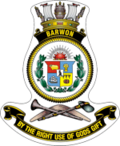
HMAS Barcoo (K375/F375/A245) was a River-class frigate of the Royal Australian Navy (RAN). One of twelve frigates constructed in Australia during World War II, Barcoo, was laid down by Cockatoo Docks & Engineering Company, Sydney in 1942, and commissioned in early 1944.

HMAS Burdekin (K376) was a River-class frigate that served the Royal Australian Navy (RAN) from 1944 to 1946. She was named for the Burdekin River in Queensland and was one of twelve River-class frigates built for the RAN during World War II.

HMAS Culgoa (K408/F408/A256), named for the Culgoa River, was a Modified River -class frigate that served in the Royal Australian Navy (RAN).

HMAS Quiberon (G81/D20/D281/F03) was a Q-class destroyer of the Royal Australian Navy (RAN). Although built for the Royal Navy and remaining British property until 1950, Quiberon was one of two Q-class destroyers commissioned into the RAN during World War II. She was passed into full RAN ownership in 1950, and converted into an anti-submarine frigate.
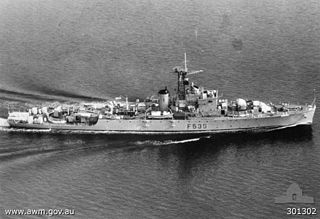
HMAS Shoalhaven (K535/M535/F535), named for the Shoalhaven River in New South Wales, was a modified River-class frigate of the Royal Australian Navy. She was laid down by Walkers at Maryborough on 18 December 1943, launched on 14 December 1944 by Senator Dorothy Tangney and commissioned at Urangan Pier in Hervey Bay in Queensland on 2 May 1946. Her first commander was Commander Rodney Rhoades.

HMAS Queenborough (G70/D270/F02/57) was a Q-class destroyer that served in the Royal Navy (RN) and Royal Australian Navy (RAN).
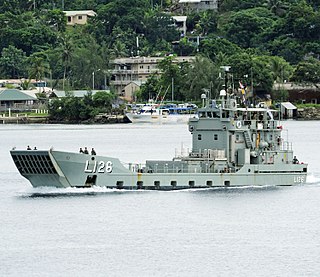
HMAS Balikpapan was the lead ship of the Balikpapan class of heavy landing craft (LCH). Ordered in 1969, Balikpapan entered service with the Australian Army Water Transport Squadron in late 1971. After this, the decision to place all seagoing Army vessels under the control of the Royal Australian Navy (RAN) saw Balikpapan transferred and commissioned in 1974; the last of the eight-vessel class to enter RAN service. Balikpapan was placed in reserve in 1985, but was reactivated three years later. During late 1999 and early 2000, the vessel was part of the INTERFET peacekeeping taskforce, and made additional deployments to East Timor in 2001 and 2006. On 12 December 2012, Balikpapan was retired from RAN service.

HMAS Benalla (J323/M323), named for the city of Benalla, Victoria, was one of 60 Bathurst-class corvettes constructed during World War II, and one of 36 initially manned and commissioned solely by the Royal Australian Navy (RAN). Built by HMA Naval Dockyard in Victoria, Benalla was fitted out as armed survey ship instead of a minesweeper like the rest of the class, and was commissioned into the RAN in 1943.

HMAS Echuca (J252/M252), named for the town of Echuca, Victoria, was one of 60 Bathurst-class corvettes constructed during World War II, and one of 36 initially manned and commissioned by the Royal Australian Navy (RAN).

HMAS Inverell, named for the town of Inverell, New South Wales, was one of 60 Bathurst-class corvettes constructed during World War II, and one of 36 initially manned and commissioned solely by the Royal Australian Navy (RAN).

HMPNGS Lakekamu is Balikpapan-class landing craft heavy (LCH) operated by the Maritime Operations Element of the Papua New Guinea Defence Force (PNGDF). The vessel was one of eight built for the Royal Australian Navy (RAN) in the 1970s, and was commissioned into the RAN as HMAS Labuan in March 1973. Labuan was decommissioned in November 2014. She was transferred to the PNGDF for use as a training ship and was commissioned as HMPNGS Lakekamu in December 2014.

HMAS Melbourne (R21) was a Majestic-class light aircraft carrier operated by the Royal Australian Navy (RAN) from 1955 until 1982, and was the third and final conventional aircraft carrier to serve in the RAN. Melbourne was the only Commonwealth naval vessel to sink two friendly warships in peacetime collisions.

HMAS Platypus was a submarine depot ship and base ship operated by the Royal Australian Navy (RAN) between 1919 and 1946. Ordered prior to World War I to support the Australian submarines AE1 and AE2, Platypus was not completed until after both submarines had been lost, and she was commissioned into the Royal Navy from 1917 to 1919.

HMAS Stuart was one of six River-class destroyer escorts built for the Royal Australian Navy (RAN). The ship was laid down by the Cockatoo Docks and Engineering Company at Cockatoo Island Dockyard in 1959, and commissioned into the RAN in 1963.
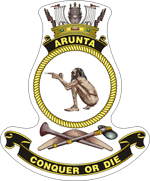
HMAS Arunta (I30/D5/D130) was a Tribal-class destroyer of the Royal Australian Navy (RAN). Named for the Arrernte Aboriginal peoples, the destroyer was laid down in 1939 and commissioned into the RAN in 1942.

The Balikpapan class is a ship class of eight heavy landing craft. All eight were originally laid down by Walkers Limited for the Australian Army in the early 1970s. A reorganisation of watercraft responsibilities in the Australian military meant the landing craft were to be operated by the Royal Australian Navy (RAN), with seven commissioned directly into RAN service during 1973 and 1974, and lead ship Balikpapan transferred from the army to the navy. During the leadup to the independence of Papua New Guinea in 1975, two of the vessels were transferred to the new Papua New Guinea Defence Force (PNGDF).

The River class was a class of six destroyer escorts operated by the Royal Australian Navy (RAN). Plans to acquire four vessels, based on the British Type 12M frigate, began in the 1950s. The first two vessels had some slight modifications to the design, while the next two underwent further changes. Two more ships were ordered in 1964, following the Melbourne-Voyager collision; these were based on the Type 12I frigate.

HMAS Diamantina (K377/F377/A266/GOR266), named after the Diamantina River in Queensland, is a River-class frigate that served the Royal Australian Navy (RAN). Constructed in the mid-1940s, Diamantina was active from 1945 until 1946, was placed in reserve, then was recommissioned as a survey ship from 1959 until 1980.
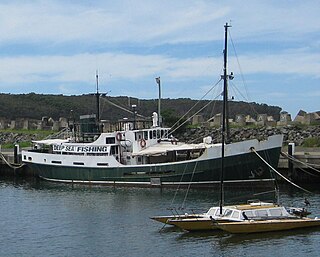
HMAS Banks was an Explorer class general-purpose vessel of the Royal Australian Navy (RAN), serving in a range of capacities from 1960 until 1995. She was named in honour of Sir Joseph Banks, the botanist aboard HM Bark Endeavour during the discovery of the eastern coast of Australia in 1770.

HMAS Hawkesbury (K363/F363) was a River-class frigate of the Royal Australian Navy (RAN). Hawkesbury saw action during World War II. She entered service with the RAN in mid-1944 and was decommissioned in 1955.

